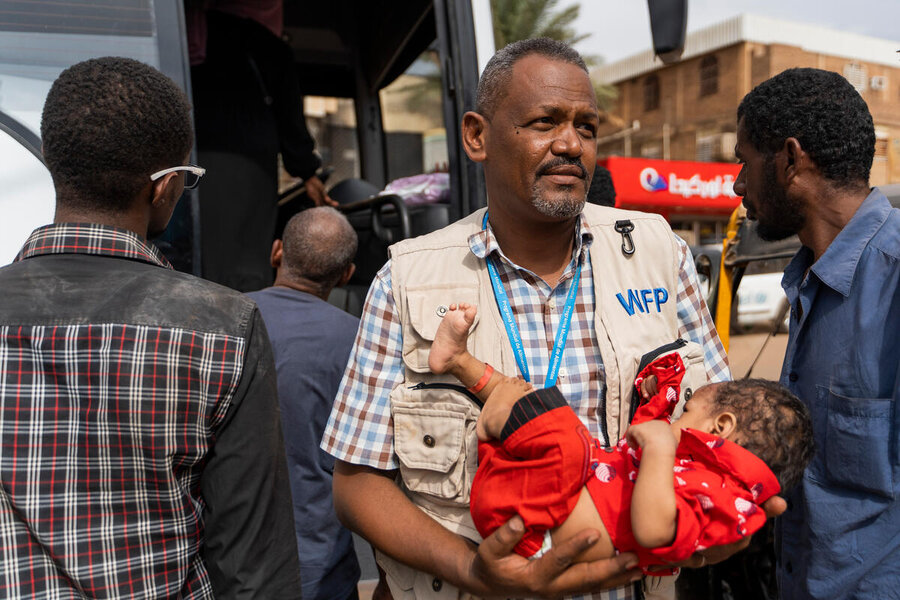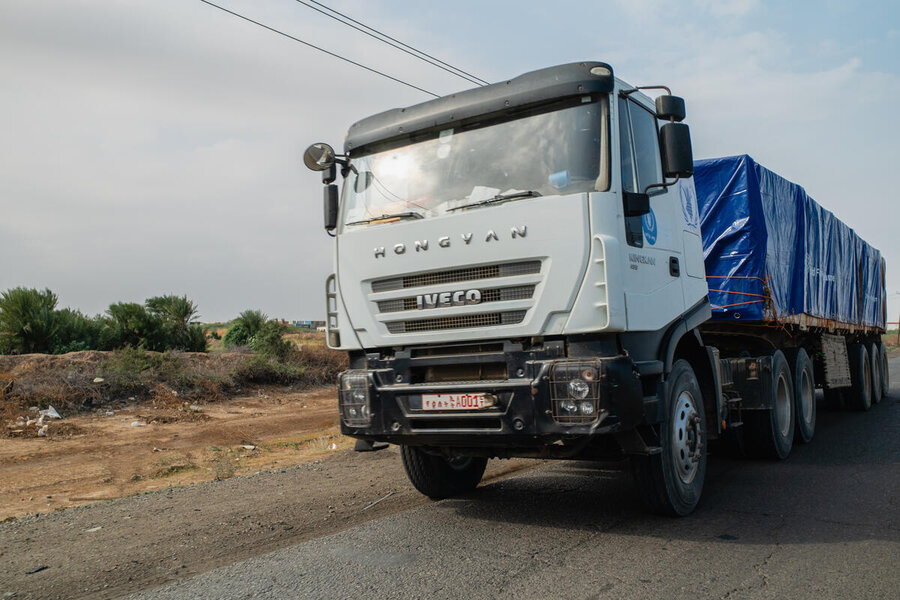WFP food reaches key Sudan city in bid to stop famine spreading

News update 26 February: WFP forced to pause food distributions in Zamzam camp
For the first time in over a year, desperately needed World Food Programme (WFP) food has finally arrived in Sudan’s conflict-hit city of Wad Madani, as part of a wider effort to reach isolated, war-torn communities countrywide and put the brakes on a growing famine.
On Monday 20 January, the first WFP trucks rolled into Wad Madani, carrying 260 metric tons of specialized nutritional foods to treat soaring malnourishment, as well as cereals, oil, salt and pulses that can feed 30,000 people for a month.
“There is a situation of extreme hunger – at least for those most vulnerable there,” WFP Sudan Acting Country Director Alex Marianelli told BBC. Pockets of extreme hunger, affecting tens of thousands of people, he said, have already been identified in Wad Madani, the capital of Sudan’s one-time breadbasket, Gezira State.

In December 2023, WFP lost access to Wad Madani – once a major humanitarian hub from which we supported 800,000 people a month. Now WFP is seizing the opportunity of a recent shift in the conflict's front lines, to resume life-saving food assistance.
Additional WFP convoys will soon be heading to Wad Madani from both Kosti, in Sudan's White Nile State, and the eastern city of Port Sudan, Marianelli said, loaded also with health, hygiene and other vital commodities from UNICEF and other humanitarian partners.
“It’s still a dangerous situation,” he said, but with increased stability, “we’ll see a larger and more comprehensive aid flow arriving in Wad Madani.”
New breakthroughs
Getting food assistance into Wad Madani counts among other recent WFP breakthroughs in delivering aid to some of Sudan’s most dangerous and isolated conflict areas, after the food agency launched a surge humanitarian assistance in late 2024 as the rainy season ended.
On Wednesday 22 January, four barges loaded with 1,000 metric tons of WFP food assistance for 80,000 people arrived in Kosti, via the White Nile River from the South Sudanese town of Renk. This shipment was months in planning, and marks the first time that WFP aid has been transported by river from South Sudan to Sudan.

"It is important because it is fast-across-water food movement from South Sudan to Sudan," said Linus Mwaji, Head of Logistics for WFP's Renk field office. "It will be crucial in meeting the food needs of people in Sudan."
Late last week, a WFP aid convoy reached Gebaish in Sudan’s West Kordofan state, carrying enough supplies to feed 7,000 South Sudanese refugees for a month. These were the first WFP trucks to arrive there since Sudan’s war broke out in 2023.
Crucially as well, WFP was finally able to deliver food assistance late last year to Zamzam displacement camp, outside North Darfur’s capital of El Fasher, where famine was confirmed in August.
And on Christmas Day, WFP led a humanitarian convoy to southern Khartoum – another first since the conflict erupted.
But with starvation spreading in Sudan, the clock is ticking to deliver thousands more tonnes of food to desperate people. Along with Zamzam, famine has been confirmed in four more areas of North Darfur, and is projected to hit a further five by mid-May, amid a rapidly deteriorating security situation. On top of that, 17 more areas of Sudan are considered at risk of famine.

Yet even as WFP secures new humanitarian routes to reach the hungry, progress overall has been patchy and fragile. Efforts to reach Zamzam camp with more assistance have been thwarted by fighting and other roadblocks – challenges witnessed elsewhere in the country.
“We need safe access, aid flowing through every border crossing and increased global support to scale up our response,” WFP Executive Director Cindy McCain has said.
Sudan is currently the only country where famine has been confirmed – and only the world’s third country to have experienced famine this century. Today, the vast East African country risks becoming the world’s largely hunger crisis in recent history, for reasons that are entirely human-made.



